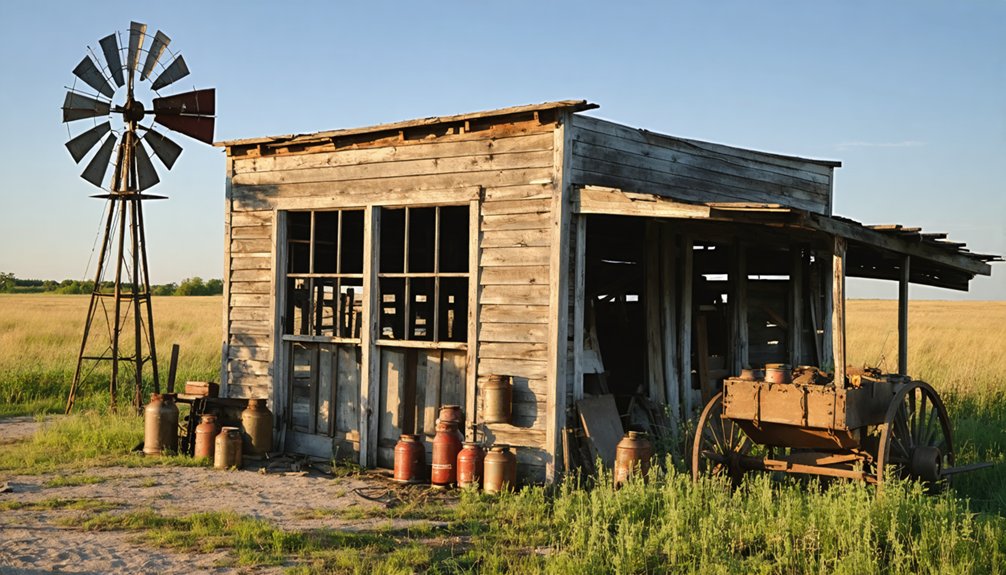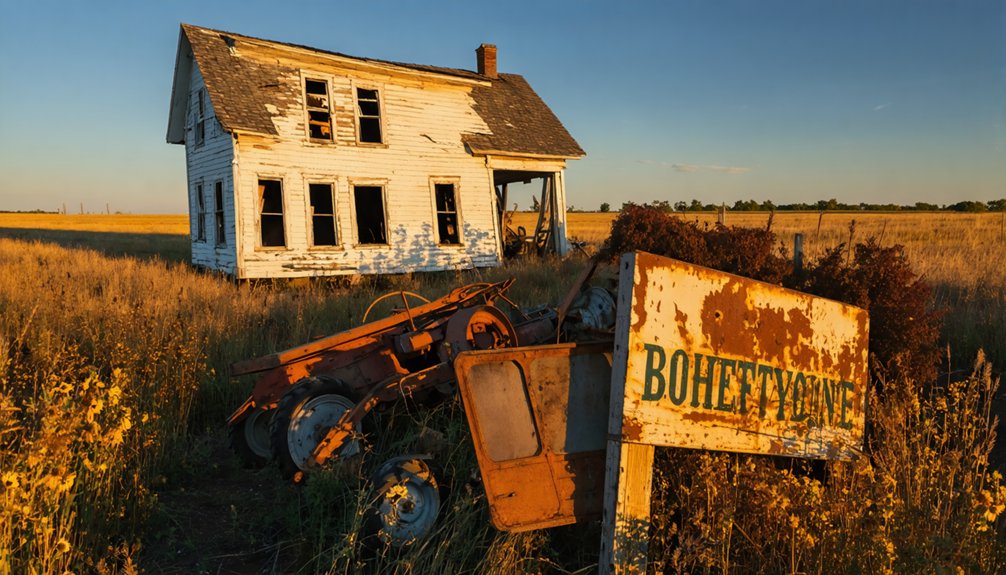You’ll find Hagginsville among South Dakota’s 600+ ghost towns, though its exact origins remain uncertain. The settlement likely emerged in the late 1800s during the Black Hills gold rush or railroad expansion, serving as a mining camp and transportation hub. While no official records, post office registrations, or newspaper archives confirm its founding date, remnants of wooden buildings, mining equipment, and stone foundations offer clues to its frontier past. The mysteries of this abandoned town’s true story await exploration.
Key Takeaways
- Hagginsville was a South Dakota mining settlement from the late 1800s, though its exact founding date and original purpose remain historically uncertain.
- The ghost town’s economy centered on mining operations, with additional support from lumber and railroad industries before its eventual decline.
- Remnants include wooden frame buildings, stone foundations, and scattered mining equipment that showcase the town’s industrial and architectural heritage.
- The site lacks modern amenities or supervision, requiring visitors to bring their own supplies and navigate unpaved roads with minimal signage.
- Local historical societies lead preservation efforts to document structures and collect oral histories while maintaining the site’s cultural significance.
Origins and Settlement Period
The origins of Hagginsville remain largely shrouded in historical uncertainty. While you won’t find this settlement in official South Dakota ghost town catalogs, several settlement theories suggest it emerged during the late 1800s, possibly during the Black Hills gold rush or railroad expansion period.
Like many frontier communities of its time, Hagginsville may have begun as a railway siding, stage stop, or mining camp. The settlers likely arrived seeking 160 acres of farmland through the Homestead Act of 1862. Similar to the bustling communities of Rockerville and Sheridan, the town likely experienced a period of mining prosperity.
The early inhabitants likely faced the typical challenges of Dakota Territory settlement – harsh weather, isolation, and the need for sustainable economic drivers.
You’ll notice a pattern common to the region’s development: small communities often sprouted up wherever transportation routes or natural resources provided opportunities.
However, without concrete historical documentation, Hagginsville’s exact founding date and original purpose continue to elude historians.
Life in Early Hagginsville
During its peak in the late nineteenth century, life in Hagginsville revolved around a tight-knit community of miners, merchants, and railroad workers who shaped the town’s social fabric.
You’d find residents gathering at local establishments like general stores and saloons, where community dynamics fostered strong social bonds despite harsh frontier conditions.
Daily life centered around mining operations, with secondary occupations in lumber and trade supporting the local economy.
Mining dominated Hagginsville’s economy, while lumber and trade activities provided essential support for the thriving frontier town.
Cultural practices included church services, informal entertainment, and social gatherings that helped residents cope with their challenging environment.
Children attended one-room schoolhouses while their parents worked in the mines or ran small businesses.
The town’s population fluctuated with seasonal workers, but family units remained the backbone of Hagginsville’s social structure, creating lasting connections that defined this frontier settlement.
Like many South Dakota towns that struggled through The Great Depression, Hagginsville saw its economic vitality severely tested during the 1930s.
Similar to neighboring ghost town Mystic, flooding and diminishing timber resources eventually contributed to Hagginsville’s decline.
Economic Foundations and Industry
Underpinning Hagginsville’s vibrant community life was a diverse economic foundation built on strategic advantages and natural resources.
You’ll find that Hagginsville’s initial growth stemmed from its position near essential transportation routes, where resource management played a critical role in the town’s development. Local businesses capitalized on the region’s natural assets, establishing mills, grain storage facilities, and trading posts to serve both residents and travelers.
Similar to Okaton, the presence of a wooden grain elevator helped establish the town as an important agricultural hub.
The town’s economic shifts reflected broader regional patterns, with commerce adapting to market demands and transportation changes.
Whether processing agricultural products, facilitating trade, or supporting nearby settlements, Hagginsville’s enterprises created a web of economic activity.
However, like many frontier towns, its prosperity remained vulnerable to external factors such as rail service changes and market fluctuations.
Notable Buildings and Architecture
When you visit Hagginsville today, you’ll find several wooden frame buildings still standing amidst the prairie landscape, offering glimpses into the town’s architectural past.
The scattered remains of mining equipment, including partially intact hoists and ore processing machinery, serve as rusted monuments to the site’s industrial heritage.
These surviving structures, though weathered by time, represent typical late 19th-century frontier construction methods, with simple designs that prioritized function over architectural embellishment. Like other historic prairie towns, many buildings reveal the lingering effects of 1930s dust storms in their worn facades.
Preserved Mining Equipment Remains
The remnants of Hagginsville’s mining operations offer a tangible glimpse into its industrial past through preserved equipment and infrastructure.
You’ll find visible traces of the town’s ore processing evolution, from early stamp mill batteries to more advanced crushing systems. A set of six stamps still stands in the city parks, proof of the original gold extraction methods. Miners used pneumatic drills extensively to create holes for strategic blasting of the rock face.
The site’s gravity-flow design utilized the natural hillside terrain, where you can spot remnants of the processing line that once moved ore efficiently from mine to mill. Mill tailings underground were pumped back into the mine’s stopes as backfill material.
While many structures were removed during reclamation, you can still examine evidence of cyanide leaching circuits and fragments of the extensive rail haulage system that once stretched 80 miles underground.
Headframes, including the iconic Yates Shaft, serve as landmarks of this once-bustling mining complex.
Standing Wooden Frame Buildings
Remnants of wooden frame buildings in Hagginsville showcase traditional early 1900s frontier construction methods and architectural styles.
You’ll find locally sourced timber used in balloon and platform framing, typical of ghost town architecture from this era. These weather-beaten structures, while deteriorating, still display the craftsmanship of their time through surviving door casings, hardware, and architectural details. Similar to the Sears catalog kit church found near the Missouri Valley, some buildings were constructed from pre-fabricated materials shipped by rail. Like many ghost town sites, these buildings stand in various states of disrepair, offering glimpses into their historical significance.
- Original wooden frame characteristics include gabled or pitched roofs, once covered with wooden shingles and later metal sheets.
- Buildings range from single-story residences to multi-story commercial structures, featuring warped wood and partial collapses.
- Window casings and hardware remain intact in several buildings, demonstrating period-specific construction techniques.
- Lead-based white paint and natural tones, now faded and peeling, reveal the authentic finishes of these frontier structures.
Daily Life and Community Stories

You’ll find that daily life in Hagginsville centered around mining operations, with residents gathering at local saloons and the general store to share news and unwind after long workdays.
The community maintained its social bonds through church meetings and informal gatherings, despite the challenges of frontier living and transient populations.
Residents faced the harsh realities of mining life, including dangerous working conditions and economic uncertainties that ultimately contributed to the town’s decline.
Community Gatherings and Events
Life in Hagginsville centered around intimate community gatherings, though records of specific events remain scarce.
You’d find the community’s social networks woven through everyday moments, from shared labor during harvests to informal meetings at the general store. While formal community traditions weren’t documented, the settlement likely followed patterns common to early 20th-century rural towns.
- Church services served as primary gathering points, reinforcing social bonds
- Mutual aid defined daily life, with neighbors helping during barn raisings and crises
- Word-of-mouth communication kept residents connected through the general store or church
- Seasonal activities like harvests brought people together for essential work and socializing
Without organized clubs or formal civic groups, Hagginsville’s residents relied on these informal gatherings to maintain their tight-knit community.
Hardships and Daily Routines
Despite the promise of gold-mining wealth, Hagginsville’s residents faced grueling daily hardships that shaped every aspect of their lives. You’d find miners enduring dangerous conditions in unstable shafts, while their families struggled with contaminated water and insufficient food supplies.
Community dynamics revolved around survival strategies, as residents shared resources and relied on barter systems during economic downturns.
The harsh South Dakota climate compounded these challenges. You’d battle extreme temperatures, floods, and wildfires, all while living in poorly constructed shelters.
Medical emergencies proved especially challenging – with no local doctors, you’d depend on home remedies or risk long journeys to distant towns. The isolation was profound, as unreliable transportation and communication left you cut off from the outside world, especially during brutal winters.
The Town’s Decline and Abandonment
While many factors contributed to Hagginsville’s eventual abandonment, the town’s decline followed patterns common to numerous South Dakota settlements of its era. The combination of economic challenges and demographic shifts created a downward spiral that proved impossible to reverse.
You’ll find several key factors that sealed Hagginsville’s fate:
- Lack of sustainable industries beyond mining led to limited employment opportunities
- Population decline accelerated as younger residents sought opportunities in larger urban areas
- Limited infrastructure development and declining services made daily life increasingly difficult
- Environmental challenges and changing economic conditions strained the remaining business operations
The town’s isolation and inability to adapt to modernizing transportation networks further hastened its decline.
Without a diversified economic base or strong community leadership, Hagginsville couldn’t sustain itself through changing times.
Archaeological Discoveries and Remains

At Hagginsville’s site, you’ll find the exposed stone and brick foundations of former buildings that hint at the town’s original layout and construction methods.
The scattered remains of mining equipment, including rusted machinery parts and tool fragments, provide tangible evidence of the town’s industrial past.
You can still observe weathered stone markers in the old cemetery, though many have become illegible over time, offering a poignant reminder of the community that once called this place home.
Unearthed Building Foundations
Numerous building foundations in Hagginsville mirror the typical archaeological patterns found across Black Hills ghost towns, consisting mainly of deteriorated stone outlines and scattered rubble.
You’ll find these foundation types are best identified through a combination of field surveys and historical research, as formal archaeological methods haven’t been extensively applied to the site.
- Stone and brick foundations have survived better than wooden structures, which have largely rotted away.
- Many foundation remains lie hidden beneath vegetation or have been obscured by years of grazing activity.
- Foundation locations are often discovered by chance through hikers or local historians rather than planned excavations.
- Archaeological identification relies heavily on comparing physical remains with historical maps and eyewitness accounts.
The site’s preservation status remains precarious, with most foundations falling into the “barren” or “neglected” categories.
Mining Equipment Remnants
Mining equipment remnants scattered throughout Hagginsville offer compelling evidence of the town’s industrial past, complementing the building foundations with tangible proof of mining operations.
You’ll find heavy iron tools weighing up to 70 pounds, while stamp mills similar to those in nearby Maitland showcase the mining technology of the era. The site reveals ore bins, shaft houses, and tramways that paint a picture of advanced industrial processes from the early 1900s.
Though many artifacts are corroded or buried under collapsed tunnels, you can still spot chemical vats with their distinctive scoured surfaces and robust iron implements that have withstood decades of exposure.
Large equipment like grindstones and ore bins remain largely intact, offering you a glimpse into the working conditions and economic impact of this once-bustling Black Hills mining community.
Cemetery Stone Markers
Granite headstones and memorial markers in Hagginsville’s cemetery provide archaeologists with vital insights into the town’s demographics and burial practices.
You’ll find various styles from rough native boulders to polished monuments, each revealing aspects of social status and cultural influences. Cemetery symbolism ranges from detailed artistic motifs to personal epitaphs, while marker preservation efforts include concrete foundations and digital documentation.
- Sandblasted and laser-etched stones feature distinctive regional designs reflecting South Dakota’s prairie heritage.
- Memorial sizes vary from modest tablets to elaborate family monuments, indicating community wealth distribution.
- Natural granite colors like Jet Black and Blue Pearl dominate the landscape.
- Military service markers and unique inscriptions offer significant data for historical research.
The cemetery’s physical remains continue to inform archaeological surveys, though weathering and erosion pose ongoing preservation challenges.
Maps and Historical Documentation

Despite extensive research efforts across historical and contemporary sources, there’s no verifiable cartographic or documentary evidence of Hagginsville’s existence as a South Dakota ghost town.
You won’t find it on any contemporary maps, digital platforms, or historical atlases. Its unverified existence raises significant questions about its authenticity as a settlement.
Standard historical documentation that typically accompanies ghost towns is remarkably absent.
There are no census records, post office registrations, newspaper archives, or railroad documents mentioning Hagginsville.
While South Dakota boasts over 600 documented ghost towns with clear historical footprints, Hagginsville lacks even basic evidence like town plats, Sanborn maps, or pioneer accounts.
This complete absence of documentation suggests the name may stem from local folklore or possible transcription errors in unofficial sources.
Visiting the Ghost Town Today
The conflicting historical records raise serious questions about planning a visit to Hagginsville’s reported location.
You’ll need to prepare carefully for this remote South Dakota ghost town experience, as it’s accessible only by unpaved roads with limited signage. The decaying structures offer compelling ghost town photography opportunities, but visitor safety is paramount given the site’s isolation and lack of facilities.
- Bring offline maps and emergency supplies – cell coverage is unreliable
- Pack all necessary water, food, and first aid equipment
- Watch for hazards like unstable buildings and wildlife
- Consider combining your visit with Badlands National Park exploration
The site’s remaining features include deteriorating commercial buildings, cabins, and a church, all being reclaimed by native vegetation.
You’ll find no amenities or supervision on-site, so self-sufficiency is essential.
Preservation Efforts and Legacy
Since its abandonment, preservation efforts for Hagginsville have centered on documenting and protecting what remains of this historically significant site. Local historical societies lead ghost town preservation initiatives through careful documentation of structures, ruins, and foundations, while collecting oral histories and photographs that capture the town’s cultural significance.
You’ll find that volunteer groups work diligently to maintain the site while respecting private property rights and preventing vandalism. These preservation activities help connect you to South Dakota’s mining and railroad heritage, offering tangible links to the region’s pioneering past.
Through guided tours, historical documentation, and educational programs, Hagginsville’s legacy lives on as a symbol of the economic shifts and demographic changes that shaped western South Dakota’s development.
Frequently Asked Questions
Were Any Paranormal Activities or Ghost Sightings Ever Reported in Hagginsville?
You won’t find any documented ghost encounters or spectral sightings in historical records there. While nearby ghost towns have paranormal claims, this location lacks specific supernatural reports or verified hauntings.
What Happened to the Residents’ Personal Belongings When They Left Town?
You’ll find residents either sold their belongings, took them along, or abandoned possessions in buildings. Many items deteriorated over time, while others became historical artifacts through scavenging, fires, and natural decay.
Did Any Famous Outlaws or Historical Figures Ever Visit Hagginsville?
You won’t find any documented visits from famous outlaws or historical figures to Hagginsville. While nearby Deadwood attracted notable characters, historical records don’t support claims of significant visitors to this small settlement.
Were There Any Unusual Laws or Ordinances Specific to Hagginsville?
Unlike Tombstone’s famous gun laws, you won’t find records of any unusual ordinances or ghost town regulations specific to Hagginsville. Historical documentation shows no evidence of distinct local laws.
Did Any Major Epidemics or Natural Disasters Affect the Town?
You won’t find specific records of epidemic impact or disaster response in this town, though it likely faced common regional challenges like disease outbreaks and severe weather typical of South Dakota.
References
- https://www.youtube.com/watch?v=Glucs_Rq8Xs
- https://www.sdhspress.com/journal/south-dakota-history-2-2/some-black-hills-ghost-towns-and-their-origins/vol-02-no-2-some-black-hills-ghost-towns-and-their-origins.pdf
- https://www.sdpb.org/rural-life-and-history/2023-08-21/some-black-hills-ghost-towns-and-their-origins
- https://www.youtube.com/watch?v=_0WNYsFLSLA
- https://icatchshadows.com/okaton-and-cottonwood-a-photographic-visit-to-two-south-dakota-ghost-towns/
- https://kxrb.com/the-journey-to-south-dakotas-hidden-ghost-town/
- https://en.wikipedia.org/wiki/List_of_ghost_towns_in_South_Dakota
- https://www.legendsofamerica.com/south-dakota-ghost-towns/
- https://mad-peak.com/blog-posts-and-info/f/black-hills-ghost-towns-are-real—and-you-can-ride-through-them
- https://www.powderhouselodge.com/black-hills-attractions/fun-attractions/ghost-towns-of-western-south-dakota/



